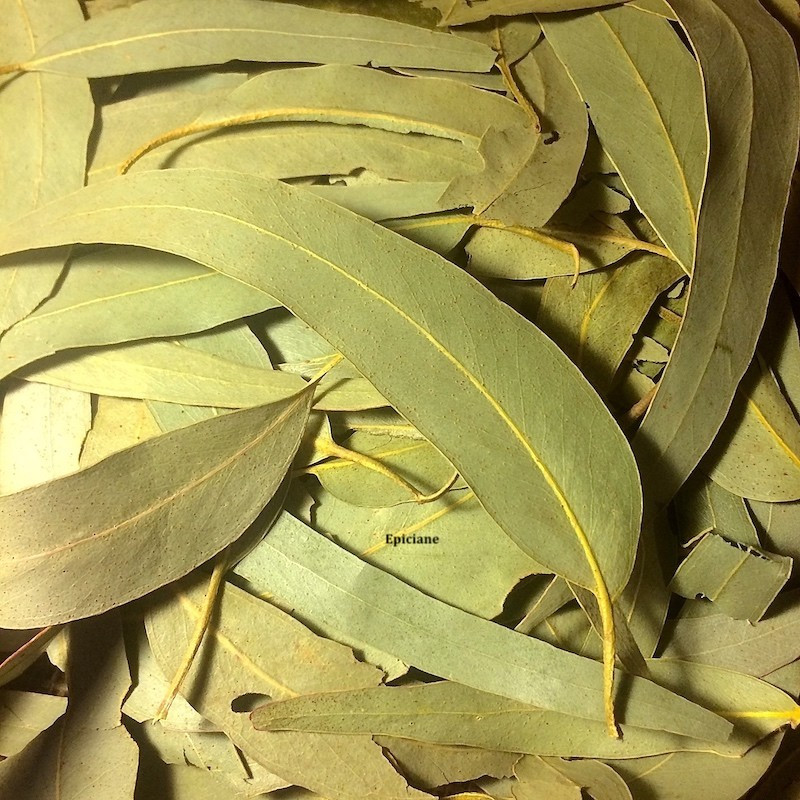
Reference: 20727901


The pleasant camphor scent of these leaves is very distinctive.
They are mainly used in teas or fumigations to combat respiratory issues, especially during the winter season.
 Delivery
Delivery
Mondial Relay
 Returns
Returns
See conditions
 Payments
Payments
100% secure
Produit livré en sachet refermable
50g correspondent à environ 60 ou 70 feuilles ENTIÈRES selon les arrivages
Uses
With these eucalyptus leaves, you can prepare fumigations, infusions, or decoctions.
Infuse a few leaves in very hot water for a few minutes. They will release their camphor fragrance and disinfecting properties, which can be inhaled during fumigations, or allowed to diffuse throughout your rooms to naturally purify the air, especially in winter.
The active component in the leaf is cineole (or eucalyptol), which has numerous benefits for the respiratory system and helps treat bronchitis, asthma, and respiratory tract inflammation. Additionally, the tree is disliked by insects (except bees during flowering season), so placing a few leaves in boiling water helps keep biting insects away.
In infusions, steep 2 to 3 grams of leaves in 150 ml of boiling water for 10 minutes. Drink two cups daily.
For inhalation, follow the same steps, and if you don’t have an inhaler, inhale the steam while covering your head with a towel.
In confectionery, eucalyptus is used in making lozenges and pastilles with mint, which are intended to soothe sore throats.
Who am I?
Origin: Spain for whole leaves and Portugal for cut leaves
Scientific name: Eucalyptus globulus
Other common names: gum tree, blue gum, koala tree, fever tree
Eucalyptus encompasses over 600 species and belongs to the large Myrtaceae family. All eucalyptus trees originate from Australia, particularly Tasmania, where they form 95% of the forests. Some species reach heights of up to 90 meters in favorable climates, making eucalyptus one of the two tallest tree species in the world. Due to its rapid growth, eucalyptus has been widely planted in certain regions, such as Portugal, for paper pulp production. It becomes invasive, destroying native vegetation and increasing the risk of massive fires due to the significant oil content in its foliage. However, it is also planted in parks and gardens in mild climates (as it doesn’t tolerate severe frost) for its ornamental shape, elegant evergreen foliage, and the unique peeling bark of certain species, which is visually appealing.
The leaves are covered in oil glands, a defining feature of this genus. Most species also have leaves that change shape and even color as the tree ages, giving the impression of different trees in the forest.
The flowers are highly varied but share numerous stamens that, before blooming, are enclosed in a capsule sealed with an operculum—hence the name “eucalyptus,” from the Greek "eu": well and "kaluptos": covered—an enclosure formed by the fusion of the flower's petals and sepals. These do not develop traditionally, leaving the flower represented only by tufts of stamens. These nectar-rich flowers are the primary source of Australian honey production. The mature fruit is a dry, brown cone.
The root system has adapted to Australia’s challenging environment, often ravaged by fires. It has developed features that allow the tree to continue absorbing nutrients and survive even when the aerial parts are destroyed by fire, enabling new growth.
Data sheet
 Josee d.
Josee d.
Très bon produit
 Jean Louis D.
Jean Louis D.
Très bien

 Josee d.
Josee d.
Très bon produit
 Jean Louis D.
Jean Louis D.
Très bien

Reference: 11N7866301
Reference: EPI230204
Reference: 3N7137901
Reference: verveine
Reference: 6N7456401
Reference: SPW06600
Reference: 7N7525705
Reference: camomilleRom
Reference: 3913
Reference: cardamomeverteE
Reference: 050721
Reference: 26545D
Reference: ecorcecitronH
Reference: 10N7738802
Reference: 2M6273801
Reference: badianeM
Reference: 108017302

The pleasant camphor scent of these leaves is very distinctive.
They are mainly used in teas or fumigations to combat respiratory issues, especially during the winter season.